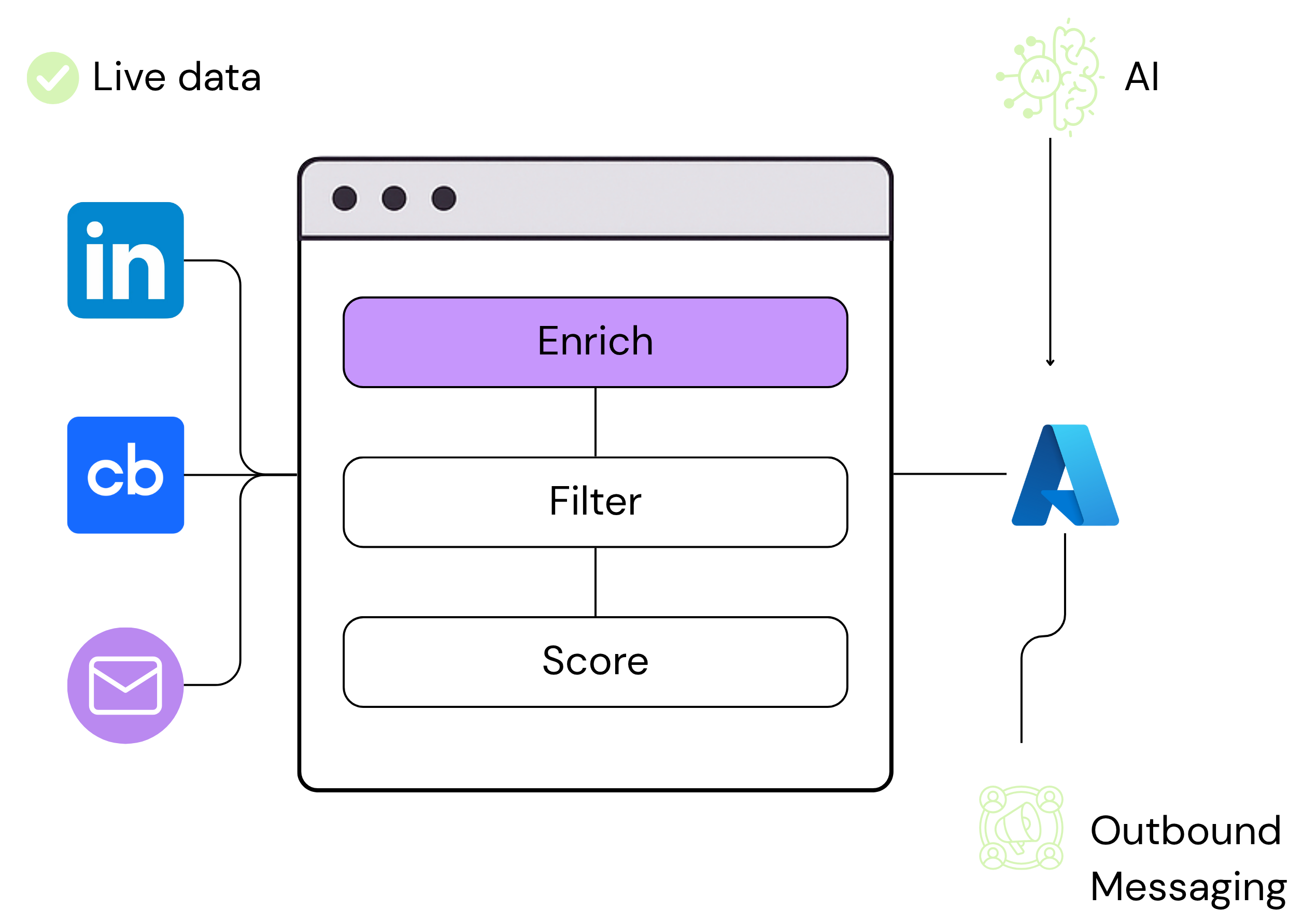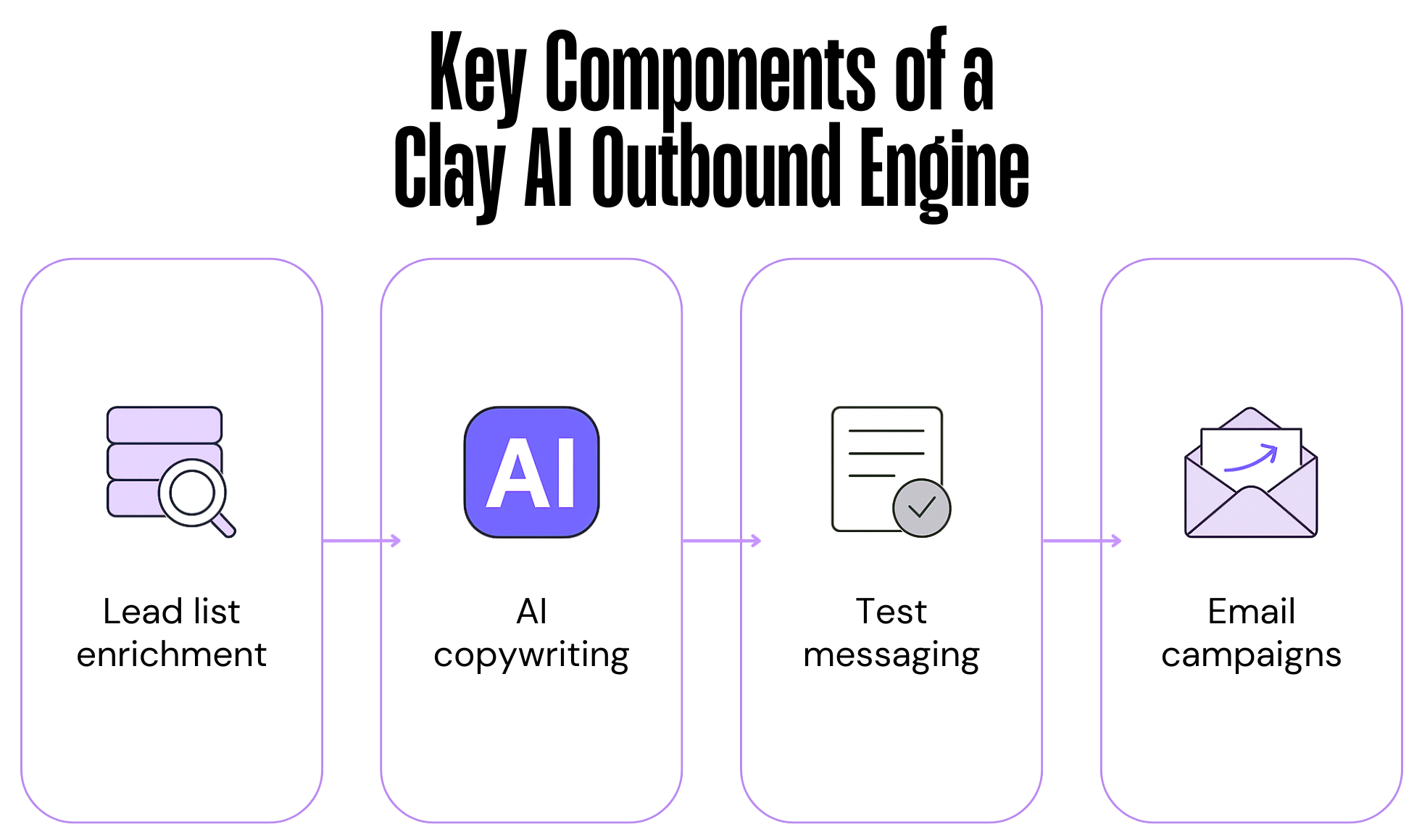Outbound isn’t dead—but traditional playbooks are. Most teams still rely on spreadsheets, CSV uploads, and rigid sequences that worked five years ago. The result? Burnt domains, disengaged buyers, and SDRs stuck in manual loops.
But a new class of teams is flipping the model. Instead of thinking of outbound as a “campaign,” they’re treating it like a product: something that’s versioned, tested, modular, and constantly improving.
With tools like Clay and AI-driven personalisation, your outbound motion can finally catch up with how fast your business moves. This article walks through how to build—and continuously evolve—a high-performance outbound engine using Clay and GPT-4.
From Static Lists to Dynamic Workflows
Old-school outbound relies on static CSVs and weekly list uploads. But prospects change fast: new roles, new funding, new initiatives. By the time your email hits, your list is already outdated.
With Clay, you don’t build a list—you build a workflow. You ingest live data (from LinkedIn, Crunchbase, or APIs), enrich it in real-time, and layer filters or AI logic to surface only the best-fit leads.
Want to only message RevOps leaders at post-Series A startups with recent hiring spikes? You can build that filter in seconds. Want to enrich every contact with their LinkedIn activity or website CTA? Add a few nodes, and it's live.
Instead of list > email > guess, Clay gives you a real-time pipeline that adapts as the world changes.

Think Like a Product Team: Modular, Testable, Adaptable
Modern outbound is less about hustle and more about architecture. With Clay and GPT-4, your outbound stack becomes modular:
- Inputs: Data from LinkedIn, Apollo, Crunchbase, etc.
- Logic: Filters, lead scoring, branching, exclusion rules
- Messaging: AI-generated first lines, summaries, or CTAs
- Output: Sequencers (Smartlead, Instantly) or CRMs (HubSpot, Salesforce)
Each component can be versioned, tested, and swapped without rebuilding the entire workflow. You can run A/B tests on GPT snippets, gate certain personas with higher scoring thresholds, or pause underperforming segments—just like a product team would.
This mindset is exactly what we described in our post on building a Clay-powered outbound engine. It’s not just about tools—it’s about how you build around them.
The “Test, Learn, Scale” Loop
One of the biggest advantages of Clay + AI is that it shortens the time from idea to impact. Here’s what that looks like:
- Test: Build a small outbound board targeting one narrow ICP. For example: product-led SaaS companies hiring their first VP of Sales.
- Learn: Run three messaging variants (e.g., funding hook, hiring reference, shared tech stack). Use GPT to generate first lines dynamically.
- Measure: Track reply rate, response type (positive/neutral/negative), and time-to-first-response.
- Scale: Once one combo hits, apply it to the next 10–50 accounts. Archive what didn’t work.
This feedback loop makes cold email feel less like roulette—and more like product iteration.

What This Means for Your SDRs
If your SDRs are spending their day copy-pasting, personalising line-by-line, and toggling between LinkedIn tabs, something’s broken.
With Clay + AI, your reps can shift from executors to operators. Their role becomes:
- Reviewing the top of funnel insights
- Spotting patterns across persona groups
- Proposing new variants to test
- Collaborating with RevOps on logic improvements
This model doesn’t just make outbound better. It makes your team better.
For teams without the luxury of brand recognition or big budgets, this shift is especially powerful. As we explored in our breakdown of how to hire SDRs with no budget or brand, a well-automated system can outperform a large headcount.
Common Mistakes in Early Clay Builds
Before you start wiring together dozens of nodes, it’s worth learning from the most common mistakes teams make when first adopting Clay + AI:
1. Overcomplicating too soon: Many teams try to build everything at once—pulling from 5 sources, adding enrichment layers, scoring logic, and three different GPT nodes. This often leads to debugging nightmares. Start simple, then layer in complexity.
2. Ignoring data cleanliness: Feeding incomplete or stale leads into Clay guarantees poor outcomes. Always start with validation—tools like Dropcontact or Clearbit ensure your inputs are worth working with.
3. Vague GPT prompts: Asking AI to “write a personalised intro” without context produces generic, flat results. Instead, structure your prompts with clear variables—job title, industry, recent event—and test a few versions.
4. No measurement plan: Teams launch workflows but forget to track response quality, enrichment success, or bounce rate. Without KPIs, you’re flying blind.
Avoiding these early traps makes your system more scalable and your SDRs more confident.
.png)
Getting Started with Clay + AI (The Light Version)
You don’t need to build a 70-node monster board on Day 1. Start lean:
- Clay (workspace and enrichment)
- 1 data source (e.g. Crunchbase or LinkedIn)
- Dropcontact or Clearbit for validation
- GPT-4 for snippet generation
- Smartlead or Instantly for outreach
From there, layer in complexity based on performance: scoring, signal-based triggers, ICP tiers, and message routing.
Metrics to Watch When Running Clay + AI
To ensure your outbound engine is actually improving, focus on these measurable signals:
- Response quality: Not just replies—but are they relevant, positive, or qualified?
- Lead enrichment rate: How many contacts are you able to fully populate with title, email, LinkedIn URL, and firmographics?
- Bounce rate: High bounce rates signal poor validation or outdated sources.
- Time-to-first-reply: A fast reply typically correlates with better targeting and timing.
- Sequence completion rate: Are prospects replying early or only after step 7? Adjust your copy and cadence accordingly.
Tracking these metrics gives you the insight you need to improve every layer—from data sourcing to GPT prompts to outreach logic.
.png)
Don’t Just Run Outbound—Build It
Outbound isn’t a static list. It’s a living, learning engine. With Clay + AI, your outbound can finally evolve alongside your strategy.
Treat it like a product: ship small, test fast, measure smart, and scale what works.
And if you need help designing the architecture? That’s exactly what we do at The Playbook Agency.

.jpeg)
.svg)
.png)


